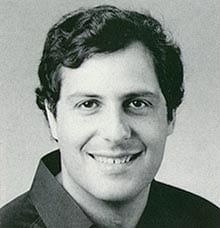Faculty Profile: Robin Ciardullo
|
Robin Ciardullo Professor of Astronomy 519 Davey Lab Phone: +1 814-865-6601 Email: rbc@astro.psu.edu |
 |
Robin Ciardullo is primarily an observational astronomer, whose research interests extend from stars in the solar neighborhood to the galaxies at high redshift, from the warm baryons of the interstellar medium to the non-baryonic Dark Matter around galaxies and clusters, and from the chemical and dynamical evolution of nearby stellar systems to the history of Dark Energy in the high-redshift universe. Much of his work concerns using a class of dying star, called planetary nebulae (PN), as a Swiss Army Knife for measurements in extragalactic astronomy and cosmology. Dr. Ciardullo was the first to show that planetary nebulae were extraordinarily accurate extragalactic distance indicators, and for the past two decades has been using these objects to better define the distance scale of the universe and the Hubble Constant. Similarly, he pioneered the use of PN as kinematic probes, exploiting their emission-line properties to measure distribution of Dark Matter in elliptical and spiral galaxies, and the dynamical evolution of galaxy clusters. He has also used PN to measure the chemical evolution of nearby galaxies, and the frequency of stellar mergers in old stellar populations.

Dr. Ciardullo is a founding member of the Hobby Eberly Telescope Dark Energy Experiment (HETDEX), a blind spectroscopic survey aimed at measuring the effects of Dark Energy at a time when the universe was only 15% of its current age. This project, which is led from the University of Texas, will obtain spectra of nearly a million Lyman-alpha emission line galaxies, located at redshifts between two and four, and use this information to measure the expansion history and curvature of the universe to better than 1%. HETDEX will also obtain spectra for over a million [O II] emitting galaxies, a quarter of a million Milky Way stars, 2000 galaxy clusters, 25,000 active galactic nuclei, and 0.4 million other objects. Dr. Ciardullo is also leading the complimentary HETDEX imaging survey, a large parallel project which will greatly enhance our ability to exploit the data products of the experiment.
Dr. Ciardullo is also a member of the Multi-wavelength Survey by Yale and Chile (MUSYC), a collaboration aimed at studying the properties of Lyman-alpha emitting galaxies between 2.1 < z < 3.1. These Lyman-alpha emitters are often called “caught in the act of formation” and are likely the progenitors of today’s Milky Way-type galaxies. The photometric, spectroscopic, and clustering properties of these objects not only produce unique insights into formation of our own Galaxy , but also provide crucial input into the experimental design of the HETDEX project.
